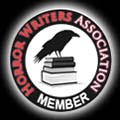HWA ANNOUNCES SUMMER SCARES READING PROGRAM: 2022 SPOKESPERSON AND TIMELINE
The Horror Writers Association (HWA), in partnership with United for Libraries, Book Riot, and Booklist, is proud to announce the fourth annual Summer Scares Reading Program. Summer Scares is a reading program that provides libraries and schools with an annual list of recommended horror titles for adult, young adult (teen), and middle grade readers. It introduces readers and librarians to new authors and helps start conversations extending beyond the books from each list and promote reading for years to come.
Summer Scares is proud to announce their 2022 spokesperson as author Alma Katsu:
"I'm thrilled to be the author representative to the Summer Scares programming committee and to have the honor of representing my fellow horror writers and be an advocate for the great writing that's being produced by the horror community. Horror is a widely-loved genre, for many readers constituting their earliest reads, whether it's R.L. Stine or Edgar Allan Poe, and so I'm happy for the opportunity to work with librarians to introduce more horror stories and new authors to their patrons."
Katsu is joined by a committee of five library workers who, together, will select three recommended fiction titles in each reading level, totaling nine Summer Scares selections. The goal of the program is to encourage a national conversation about the horror genre, across all age levels, at libraries nationwide and ultimately attract more adults, teens, and children interested in reading. Official Summer Scares designated authors will also make themselves available at public and school libraries.
The committee’s final selections will be announced on February 14, 2022, Library Lover’s Day. Katsu, along with some of the selected authors, will appear on a panel to kickoff Summer Scares at the 6th Annual HWA Librarians’ Day, Friday May 13 during StokerCon 2022 at the Curtis Hotel in Denver, CO.
Between the announcement of the titles and the kickoff event, the committee and its partners will publish lists of more suggested titles for further reading. Official Summer Scares podcasting partner, Ladies of the Fright Podcast, will also record episodes in conjunction with Summer Scares.
Of special note is the annual Summer Scares Programming Guide, courtesy of Konrad Stump and the Springfield-Greene County Library, which provides creative ideas to engage horror readers. Centered around the official Summer Scares titles, the guide offers tips and examples for readers’ advisory, book discussions, and special programs, and enables librarians, even those who don’t read or especially enjoy the horror genre themselves, to participate in Summer Scares. As Stump notes:
“The Springfield-Greene County (MO) Library is thrilled to continue working with the HWA to produce the 2022 Summer Scares Programming Guide. We’re excited to announce that not only will 2022’s guide be enhanced through an exciting new partnership with the Horror Studies archive at Pitt University, but we will be releasing the guide earlier than ever, on March 1, so library workers have more time to plan fun and thought-provoking programs that engage their communities with horror and Summer Scares.”
To see past year’s Summer Scares titles, spokespeople, and programming guides, please visit the program archive: http://raforallhorror.blogspot.com/p/summer-scares-archive.html.
And keep your eyes peeled for more updates coming soon from Booklist, Book Riot, and United for Libraries, as well as at the HWA’s website: www.horror.org and RA for All Horror: http://raforallhorror.blogspot.com/p/summer-scares.html.
Questions? Reach out to HWA Library Committee Chairs Becky Spratford and Konrad Stump via email: libraries@horror.org.
+++++++++++++++++++++++++
Summer Scares Committee Members:
Alma Katsu is the author of six novels. Her books have twice-nominated for the Stoker and Locus awards and been on best books lists at Amazon, Apple, Goodreads, Barnes & Noble, among others. THE HUNGER (2018), one of last year’s Summer Scares adult picks, was named one of NPR’s 100 favorite horror stories, and won Spain’s Kelvin 505 award for best scifi/fantasy novel as well as the Western Heritage Award for best novel. THE DEEP (2020) is a finalist for the Library of Virginia’s best novel award. Her most recent work, RED WIDOW (2021), is her first spy novel, the logical marriage of her love of storytelling with her 30+ year career at CIA and NSA. RED WIDOW was selected a NYT Book Review Editor’s Choice and is in development with FOX for a TV series.
Ms. Katsu has relocated from the Washington, DC area to the mountains of West Virginia, where she lives with her musician husband Bruce and their two dogs, Nick and Ash.
Becky Spratford is a library consultant and the author of The Readers’ Advisory Guide to Horror, third edition which was released in September of 2021. She reviews horror for Booklist Magazine, is the horror columnist for Library Journal and runs the Readers’ Advisory Horror blog, RA for All: Horror. Becky is also a member of United for Libraries and is currently serving as Secretary for the Horror Writers’ Association.
Konrad Stump is a Local History Associate for the Springfield-Greene County (MO) Library, where he coordinates local history programming and works district-wide on Big Read, ASRP, and Springfield-Greene's popular “Oh, the Horror!” series, which attracts hundreds of patrons during October. He created the Donuts & Death horror book discussion group, featured in “Book Club Reboot: 71 Creative Twists” (ALA), and co-created the Summer Scares Programming Guide. Library workers and authors who are interested in cultivating horror programming can contact Konrad at konrads@thelibrary.org for free assistance.
Carolyn Ciesla is an academic library director in the Chicago suburbs. She has worked as a teen librarian and reference librarian, and reviews horror titles for Booklist Magazine. She’s currently enjoying providing all the scary books to her teen daughter, and revisiting a few along the way.
Kelly Jensen is a former librarian who works as an Editor for Book Riot (bookriot.com), where she runs the bi-weekly "What's Up in YA?" young adult newsletter and cohosts the popular "Hey YA" podcast about young adult literature Her books include the award-winning (Don’t) Call Me Crazy: 33 Voices Start the Conversation About Mental Health and Here We Are: Feminism for the Real World, both from Algonquin Young Readers. She's also a well-known and long-time co-blogger at Stacked (stackedbooks.org). A life-long lover of all things scary, she finds herself eager to scream about horror reads for teens with those who love good thrills and chills.
Julia Smith joined the Books for Youth team at Booklist in 2015, where she is now a senior editor. Her life-long love of horror movies and middle-grade literature draws her to creepy children's stories and books with bone in the title. You can follow her at @JuliaKate32 on Twitter.








